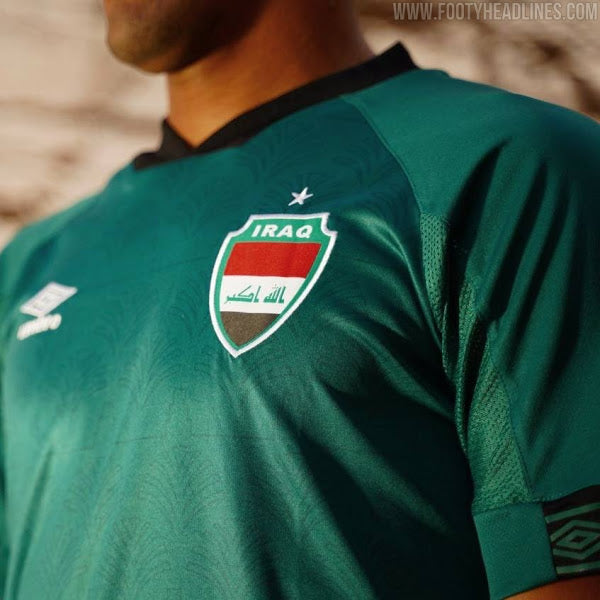
Iraq New Umbro Jersey
Iraq launch new football jersey
Although they are not involved in either of this summer’s big two tournaments, the Euros or Copa Amèrica, Iraq have staked a claim for the best new football jersey to come out since the 2018 Nigerian World shirt that flew off the shelves across Europe when it was unveiled three years ago.
And whilst the new Ukraine shirt has attracted headlines for its political connotations, it is they style and aesthetics of the new Iraq football jerseys, both home and away, that are catching the eye.
Two new designs were unveiled in the launch last week by the official merchandise partner of the Iraq football team, Umbro.
Both the home and away kit are inspired by symbols of the ancient Mesopotamian culture that has led to Iraq being called the “cradle of civilisation”.
The home Iraq Umbro jersey is a deep hue of green and features across the front the Babylon palm n a graphic pattern. This symbolises not only victory but references the walls of the Ishtar Gate, once one of the eight entrances to the legendary ancient city of Babylon (about 50 miles south of modern Baghdad).
This Iraq shirt comes with a V-neck, in teal, whilst there is diamond piping in the same colour around the edge of the sleeve The national flag of Iraq is emblazoned across the left shirt pocket, whilst the Umbro logo is on the opposite site.
On the back of the shirt, meanwhile, there is “Iraq” written in traditional Arabian script, in the centre of the shirt.
The new away Iraq football jersey is predominantly white, but retains the teal trimmings. One difference though is that the Babylon palm tree graphic, has been enhanced by the addition of Assyrian rosettes, small; flower symbols commonly associated with ancient Assyrian art.
In addition, the badge and the Umbro diamond symbol have been aligned vertically in the centre of the jersey.
The new kits are something of a radical departure from Iraq football kits of the past, and, arguably, have the advantage of being less busy. Compare them for example, to the home kit from two years ago, which saw the front split into three horizontal panes in the colours of the national flag, with green Arabic script across the middle “white” section.
In fact, they are closer to the home kit the team began the year playing, except that the diagonal strike, stripe that was such a feature of that Iraq shirt has now been ditched.
Some, though, may regret the demise of the 2020/2021 away shirt, which again was predominantly white, but which featured the outlines of a representation of a lion in green. That has attracted a loyal fan base among cognoscenti, not only among Iraq footy fans, and many will be sorry to see them go (although they may now be able to pick up a bargain in clearance sales as sporting good stores make room for the new lines).
It is an exciting time to be an Iraq football fan. The team are leading their second round World Cup qualifying group, with two matches to play, and seem almost certain to make it through to the third round.
Finish then in the first two places in either group and they will automatically earn themselves a place at the 2022 World Cup in Qatar. Even a third placed finish will earn them a place in the fourth round and the chance to be involved in an inter-confederation play-off.
If they do make it to Kuwait, it will only be the second time in their history, that Iraq will have made it to the World Cup finals. The only other time was in Mexico in 1986, when drawn in a group with the hosts Mexico, Belgium, and Paraguay, they lost all three matches, narrowly, and scored just one goal.
Of course, it is traditional for many Middle Eastern countries to play in green because it represents the religion of Islam, and many local people associate it with peace and spirituality. That is allied with the red, white, and black of the Iraq flag – red representing the nations courage and struggles white for the future and generosity of its people; and black for its historic oppression and subsequent triumph of Islam.
In some cultures, though, green is considered unlucky, and, in sporting circles, those who race cars in a green livery are judged likely to be cursed with bad luck.
There is actually some correlation with football as well. Research carried out on all the home and away games since the beginning of the Premier League in 1992, found that teams that played in green shirts performed worst of all – more than half of all games played in the colour were lost.
There are various theories for this, with suggestions that the colour matches the pitch too closely, making it harder to see teammates.
(For some this may evoke memories of the time that Sir Alex Ferguson ordered his Manchester United team to change shirts at half-time, the only and only time in his reign when they wore grey shirts, when he found his team trailing by three goals).
Meanwhile white, the colour of the away Iraq shirt, is the most likely to produce a draw statistically, suggesting that its s best not to wear this for a vital game if a win is required.
It may also be pointed out that the most successful winners in terms of the World Cup are Brazil and they play in yellow and green, and the flag of four time winners Italy also contains green.
Others contend that it is what happens in the pitch that counts anyway, and, for now, Iraq, wearing their new kits, have a major test ahead of them. Assuming they beat Hong Kong on Friday, they have a must win – or at least, must not lose - match against their traditional foes, Iran, next Tuesday.
If they can get a positive result in that match wearing their new Iraq football jersey, then most of their fans will not care about its colour.


